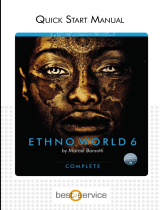Page is loading ...

USER’S MANUAL

The information in this document is subject to change without notice and does not represent a
commitment on the part of Native Instruments GmbH. The software described by this document is
subject to a License Agreement and may not be copied to other media. No part of this publication
may be copied, reproduced or otherwise transmitted or recorded, for any purpose, without prior
written permission by Native Instruments GmbH, hereinafter referred to as Native Instruments. All
product and company names are ™ or ® trademarks of their respective owners.
Manual written by Dan Powell and James Thompson
Document Version: 1.0 (09/2009)
Product Version: 1.0 (09/2009)
Special thanks to the Beta Test Team, who were invaluable not just in tracking down bugs, but in
making this a better product.

Germany
Native Instruments GmbH
Schlesische Str. 28
D-10997 Berlin
Germany
info@native-instruments.de
www.native-instruments.de
USA
Native Instruments North America, Inc.
5631 Hollywood Boulevard
Los Angeles, CA 90028
USA
sales@native-instruments.com
www.native-instruments.com
© Native Instruments GmbH, 2009. All rights reserved.

Balinese Gamelan – IV
Table Of Content
1 Introduction ......................................................................................................................5
1.1 The Core Instruments ..............................................................................................5
1.2 The Gangsa .............................................................................................................6
1.3 The Kettle Gongs .....................................................................................................6
2 The Kontakt Front Panels...................................................................................................7
2.1 Simple Instruments .................................................................................................7
2.2 Synth Instruments ...................................................................................................8
2.2.1 Tweak Page ...................................................................................... 8
2.2.2 Jammer Page ................................................................................... 8
2.2.3 Gamelan Pairs Page .........................................................................10
2.2.4 Tweak Control Page ..........................................................................10
2.2.5 Jammer Control Page .......................................................................11
3 More about the Gamelan Instruments ............................................................................... 12
3.1 The Core Instruments ........................................................................................... 12
3.1.1 Gongs ............................................................................................12
3.1.2 Calung, Panyacah and Jegog .............................................................13
3.2 The Gangsa ...........................................................................................................14
3.2.1 Ugal .............................................................................................. 14
3.2.2 Kantilan and Pemadé .......................................................................15
3.3 The Kettle Gongs ................................................................................................... 16
4 Kontakt KSP “Gamelan Retune” Script ............................................................................. 17
5 Credits ........................................................................................................................... 18

Powered-By – Balinese Gamelan – 5
SPRACHE IN Paragraph-Style “05 - STANDARD Fließtext” passend einstellen
1 Introduction
Welcome to Soniccouture’s Balinese Gamelan!
For this edition of Balinese Gamelan, we provide three instruments that represent the three
main structural elements of Balinese Gamelan music.
For each of these we provide Original Pitch and Concert Pitch versions, (designated by OP
or CP in the lename and seperated to folders “Concert Pitch” and “Original Pitch”). If you
want your music to sound like real gamelan, the Original Pitch is preferable. However, if you
want to layer your gamelan with other western instruments, you might nd Concert Pitch
easier to work with.
For each Instrument we provide both a simple and a “synth” version.
1.1 The Core Instruments
These are the instruments that lay out the basic structure and melody, including the Gongs,
the Jegog, the Calung, and the Penyacah. In tradtional gamelan, the largest Gong will mark
the end of each cycle, and the Calung will play a simple version of the “core melody”.
The Jegog will double every other note of the Calung melody an octave below.
Generally, in Balinese music, the lower the pitch the slower the instrument plays.
The Jegog, Calung, and Penyacah are doubled in detuned pairs. This produces a constant
beating effect, typcial of Balinese gamelan.

Powered-By – Balinese Gamelan – 6
1.2 The Gangsa
The Gangsa include the Ugal, Pemadé, and Kantilan. This are the busy elaborate instruments
that decorate the melody with fast interlocking patterns.
The upper Gangsa instruments are also in detuned pairs, again providing a shimmering
quality to the orchestra.
1.3 The Kettle Gongs
The Kettle Gongs include the Trompong and the Reyong. These instruments have various
functions depending on the type of gamelan in which they’re used. Sometimes they are used
for melodic decoration or solo passages, other times they can be used for very quick elaborate
parts, similar to the gangsa. The Kettle Gongs are not in detuned pairs.

Powered-By – Balinese Gamelan – 7
2 The Kontakt Front Panels
2.1 Simple Instruments
Front panel controls for simple Instruments
In each of the KONTAKT Instruments you will nd front panel controls for attack and release
times, which adjust those parameters directly. The Velocity and Timing knobs introduce a
slight randomicity to those parameters, helping to provide a “humanizing” effect.
In the Core and Gangsa Instruments you will also nd knobs for adjusting the level and
panning for each instrument in the detuned pair.

Powered-By – Balinese Gamelan – 8
2.2 Synth Instruments
There are numerous controls In the synth version of each instrument as well as several pages
with access to various parameters. These versions are better suited for sound manipulation
if you want to manipulate the gamelan beyond it’s natural sound.
2.2.1 Tweak Page
Tweak page
The Tweak page gives you knobs to adjust the LPF Filter, including cutoff, resonance, envelope
depth (FEG), FEG Attack and FEG Decay times. There are also knobs for a high pass lter
(HPF), the amplitude attack and release times, and a delay and reverb send. The reverb send is
in fact a convolution and you have a pull down menu with various different impulse responses.
2.2.2 Jammer Page
Jammer page

Powered-By – Balinese Gamelan – 9
The Jammer page provides control over a function quite similar to an arpeggiator. It’s similar
in that notes you hold down will be played automatically; but which note will be triggered at
a given moment is randomly selected from those you hold down.
See the following list for an explanation of the Jammer’s controls:
• Jam ON enables or disables the Jammer effect. When the Jammer is on, all throughput
of MIDI is disabled, you only hear the output of the Jammer.
• Time is a drop-down menu that allows you to choose the repeat speed. This will always
sync to the tempo of KONTAKT or your host sequencer.
•
Double Hits will trigger two notes on each repetition, as if you are playing with both hands
simultaneously.
•
MW Vel is a depth setting that allows you to add or subtract velocity using the Modulation
wheel. This will affect notes already held down so you can make swells or fades while the
Jammer is already rolling.
•
The Randomize section allows you to introduce randomicity to the notes as they are being
generated.
▪
Randomize Velocity will add or subtract a random amount of velocity for each note, up
to a maximum that you set. This is always in relation to the last played velocity you
triggered with your keyboard or sequencer.
▪
Randomize Note will add or subtract a random value for the MIDI note, which can be
useful especially using the zoned Instruments.
▪
Randomize Octave will randomly add an octave or more (maximum 3) to the generated
notes. Note that Octave only introduces added octaves, not subtractions.
▪ Randomize Timing is best used very subtly if you want to introduce a bit of “human
error” into the timing. At higher settings it’s a bit avant-garde.

Powered-By – Balinese Gamelan – 10
2.2.3 Gamelan Pairs Page
Gamelan Pairs page
The Gamelan Pairs page gives you access to the volume and panning for the two detuned
elements of the Gangsa or the Core instruments. It is not available in the Kettle Gongs
instruments since those are not detuned.
2.2.4 Tweak Control Page
Tweak Control page
The Tweak Control page allows you to assign MIDI controllers to the knobs in the Tweak page.
This is useful if you have a hardware controller, or want to sequence changes to those parameters.

Powered-By – Balinese Gamelan – 11
2.2.5 Jammer Control Page
Jammer Control page
The Jammer Control page allows you to assign MIDI controllers to the knobs in the Jammer
page. This is useful if you have a hardware controller, or want to sequence changes to those
parameters.

Powered-By – Balinese Gamelan – 12
3 More about the Gamelan Instruments
3.1 The Core Instruments
3.1.1 Gongs
Klentong
Gong Wadon
The Gong Wadon, the deepest gong, is usually the main gong of a rhythmic cycle, marking
the beginning or end of a structural section. The other gongs mark divisions within the cycle.

Powered-By – Balinese Gamelan – 13
3.1.2 Calung, Panyacah and Jegog
Calung
The Calung generally plays the “core melody” of a piece, which often tends to be much slower
than the perceived speed of the music. In gamelan, the “core melody” is a kind of a structural
base upon which all the other instrumental parts are based. The higher instruments will often
play much more quickly, elaborating on this core melody in various ways.
Panyacah
Although the Panyacah is a core melody instrument, it is pitched quite high and therefore
helps the core melody to ring through the texture. Usually it matches or doubles the rhythmic
density of the Calung part.
Jegog
The Jegog will play more slowly, usually re-inforcing important notes from the Calung part
and any gongs in the cycle.

Powered-By – Balinese Gamelan – 14
Keyboard Layout
Here is a map of the keyboard layout for the three “colotomic”, or core melody instruments:
3.2 The Gangsa
3.2.1 Ugal
Ugal
The Ugal is the lowest pitched, and the leader of the “gangsa” section of the gamelan. It
usually plays the core melody or an elaboration of the core melody.

Powered-By – Balinese Gamelan – 15
3.2.2 Kantilan and Pemadé
Kantilan
Pemadé
The Kantilan and Pemadé ll out the higher registers of the gangsa section with a texture of
rapid intertwining patterns, which decorate the core melody. Usually the gangsa is the fastest
and most ornate content of a gamelan piece.
In real life, the fast passages on Kantilan and Pemadé are played using a technique called
“kotekan”, in which successive notes are shared between two players, enabling them to play
much faster passages than would be possible for a single player.
Keyboard Layout

Powered-By – Balinese Gamelan – 16
3.3 The Kettle Gongs
The Kettle Gongs are not paired instruments, but solo melodic and decorative instruments.
We have provided a combined instrument that includes the lowest notes of the trompong to
the highest notes of the reyong, for maximum range.
Kettle Gongs
The Kettle Gongs are very prominent in Kebyar styles, and are often played by four musicians
sitting side by side, each responsible for a few notes. These intertwining patterns decorate
certain passages, or are featured as a solo section for a piece.
Keyboard Layout

Powered-By – Balinese Gamelan – 17
4 Kontakt KSP “Gamelan Retune” Script
We include a KSP script with this library called “SC Gamelan Retune.nkp.” This script will
retune any KONTAKT Instruments you have tuned to the gamelan tuning. This is handy if you
want to layer the gamelan with other instruments, using the Balinese tuning.
Put this script into your KSP presets library, and it will available to any instrument in Kontakt.
The script has only one control, which is a switch between “Lower” and “Upper”. Since many
of the Balinese instruments are in pairs, and each of the pairs are tuned differently, you can
choose which of these you want to tune a non-gamelan instument to.
If you double an accompanying instrument, and tune one to “Upper” and the other to “Lower”,
you will create a similar detune beating to that found in the gamelan itself. If you don’t double
your accompanying instruments, we recommend using the “Upper” tuning, since it’s more
consistent across octaves.

Powered-By – Balinese Gamelan – 18
5 Credits
Recording, sound design, post-production & graphic design by Dan Powell and James
Thompson
/







